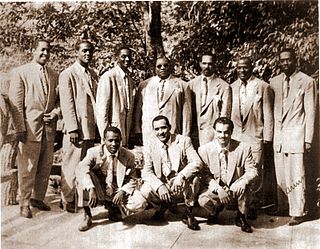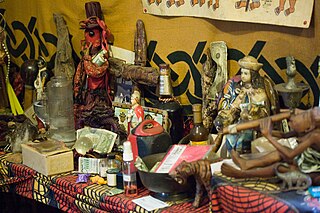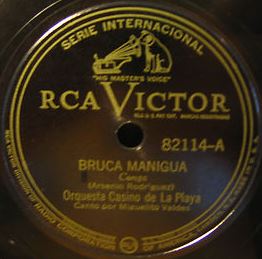The music of Cuba, including its instruments, performance, and dance, comprises a large set of unique traditions influenced mostly by west African and European music. Due to the syncretic nature of most of its genres, Cuban music is often considered one of the richest and most influential regional music in the world. For instance, the son cubano merges an adapted Spanish guitar (tres), melody, harmony, and lyrical traditions with Afro-Cuban percussion and rhythms. Almost nothing remains of the original native traditions, since the native population was exterminated in the 16th century.

Arsenio Rodríguez was a Cuban musician, composer and bandleader. He played the tres, as well as the tumbadora, and he specialized in son, rumba and other Afro-Cuban music styles. In the 1940s and 1950s Rodríguez established the conjunto format and contributed to the development of the son montuno, the basic template of modern-day salsa. He claimed to be the true creator of the mambo and was an important as well as a prolific composer who wrote nearly two hundred songs.

Lydia Cabrera was a Cuban independent ethnographer, writer, and literary activist. She was an authority on Santería and other Afro-Cuban religions. During her lifetime she published over one hundred books; little of her work is available in English. Her most important book is El Monte, which was the first major ethnographic study of Afro-Cuban traditions, herbalism and religion. First published in 1954, the book became a "textbook" for those who practice Lukumi and Palo Monte both religions reaching the Caribbean through enslaved Africans. Her papers and research materials were donated to the Cuban Heritage Collection - the largest repository of materials on or about Cuba located outside of Cuba - forming part of the library of the University of Miami. A section in Guillermo Cabrera Infante's book Tres Tigres Tristes is written under Lydia Cabrera's name, in a comical rendition of her literary voice. She was one of the first writers to recognize and sensitively publish on the richness of Afro-Cuban culture and religion. She made valuable contributions in the areas of literature, anthropology, art, ethnomusicology, and ethnology.

African diaspora religions, also described as Afro-American religions, are a number of related beliefs that developed in the Americas in various nations of the Caribbean, Latin America and the Southern United States. They derive from traditional African religions with some influence from other religious traditions, notably Christianity and Islam.

The culture of Cuba is a complex mixture of different, often contradicting, factors and influences. The Cuban people and their customs are based on European, African and Amerindian influences.
Palo, also known as Las Reglas de Congo, is an African diasporic religion that developed in Cuba during the late 19th or early 20th century. It arose amid a process of syncretism between the traditional Kongo religion of Central Africa, the Roman Catholic branch of Christianity, and Spiritism. An initiatory religion practised by paleros (male) and paleras (female), Palo is organised through small autonomous groups called munanso congo, each led by a tata (father) or yayi (mother).

Afro-Cubans or Black Cubans are Cubans of full or partial sub-Saharan African ancestry. The term Afro-Cuban can also refer to historical or cultural elements in Cuba associated with this community, and the combining of native African and other cultural elements found in Cuban society, such as race, religion, music, language, the arts and class culture.

Abakuá, also sometimes known as Ñañiguismo, is an Afro-Cuban men's initiatory fraternity or secret society. It originated from fraternal associations in the Cross River region of present-day southeastern Nigeria and southwestern Cameroon.
Cabildos de nación were African ethnic associations created in Cuba in the late 16th century based on the Spanish cofradías that were organized in Seville for the first time around the 14th century. The Sevillian cofradías had the tutelage of a Catholic saint and were held in the saint’s chapel.

Africanisms refers to characteristics of African culture that can be traced through societal practices and institutions of the African diaspora. Throughout history, the dispersed descendants of Africans have retained many forms of their ancestral African culture. Also, common throughout history is the misunderstanding of these remittances and their meanings. The term usually refers to the cultural and linguistic practices of West and Central Africans who were transported to the Americas during the trans-Atlantic slave trade. Africanisms have influenced the cultures of diverse countries in North and South America and the Caribbean through language, music, dance, food, animal husbandry, medicine, and folklore.
The Arará people form an Afro-Cuban ethnoreligious group descended from the Dahomey kingdom of West Africa, and retaining an identity, religion, and culture separate from those of other Afro-Cuban peoples. Although, historically, the Arará people have been staunch defenders of their separate heritage and religion, this distinct identity - while it still persists - has, over time, become increasingly blurred and harder to maintain.
Christianity is the most widely professed religion in Cuba, with Catholicism being its largest denomination. A significant share of the Cuban population is either non-religious or practices folk religions.

Rumba is a secular genre of Cuban music involving dance, percussion, and song. It originated in the northern regions of Cuba, mainly in urban Havana and Matanzas, during the late 19th century. It is based on African music and dance traditions, namely Abakuá and yuka, as well as the Spanish-based coros de clave. According to Argeliers León, rumba is one of the major "genre complexes" of Cuban music, and the term rumba complex is now commonly used by musicologists. This complex encompasses the three traditional forms of rumba, as well as their contemporary derivatives and other minor styles.

Santería, also known as Regla de Ocha, Regla Lucumí, or Lucumí, is an African diasporic religion that developed in Cuba during the late 19th century. It arose through a process of syncretism between the traditional Yoruba religion of West Africa, the Roman Catholic form of Christianity, and Spiritism. There is no central authority in control of Santería and much diversity exists among practitioners, who are known as creyentes ("believers").
Lucumí is a lexicon of words and short phrases derived from the Yoruba language and used for ritual purposes in Cuba and the Cuban Diaspora. It is used as the liturgical language of Santería in Cuba and other communities that practice Santería/Cuban Orisa/the Lucumí religion/Regla de Ocha.
Kontradans or the French-Haitian Contredanse, is creolized dance music formed in the 18th century in the French colony of Saint-Domingue (Haiti) that evolved from the English contra dance, or, which eventually spread throughout the Caribbean, Louisiana, Europe and the rest of the New World from the Creoles of Saint-Domingue.
The religion of Haitian Vodou has been present in Cuba since at least the 18th century. It was transmitted to the island by Haitian migrants, the numbers of whom grew rapidly in the early 20th century, and is primarily practised by their descendants. It is distributed primarily in eastern parts of the island, especially in Oriente. In Cuba, some practitioners of Haitian Vodou have also become involved in the related Afro-Cuban religion of Santería.

"Bruca maniguá" is an afro-son composed by Arsenio Rodríguez in 1937. It was first recorded by Orquesta Casino de la Playa featuring Miguelito Valdés on vocals in June 1937. Ever since it has become a Cuban son standard, with famous versions by Abelardo Barroso, Sierra Maestra, Buena Vista Social Club and Ibrahim Ferrer. The song, which has been called "a landmark in the development of Cuban popular music" by Ned Sublette, was Arsenio Rodríguez's first hit and an example of his Afro-Cuban style of son within the afrocubanismo movement.
Tahona, alternatively spelled tajona due to its pronunciation or taona, is a secular style of Afro-Cuban music developed in the 19th century in Santiago de Cuba after the arrival of Haitian slaves following the Haitian Revolution. It is named after the ensembles and the drums played by them. It is considered one of the oldest styles within the rumba complex, and its performance became rare by the 20th century.
Coros de clave were popular choral groups that emerged at the end of the 19th century in Havana and other Cuban cities. Their style was influenced by the orfeones which grew popular in northern Spain in the mid-19th century, and their popularization in the island was linked to the emancipation of African slaves in 1886. The common instrumentation of the coros featured a viola, claves, guitar, harp and jug bass.










